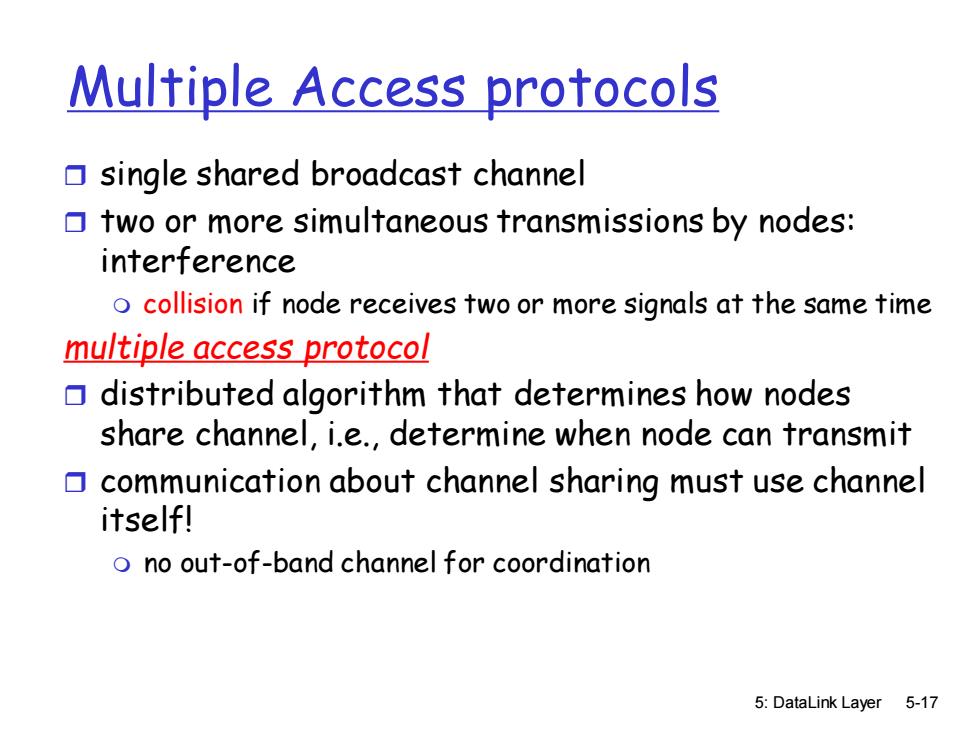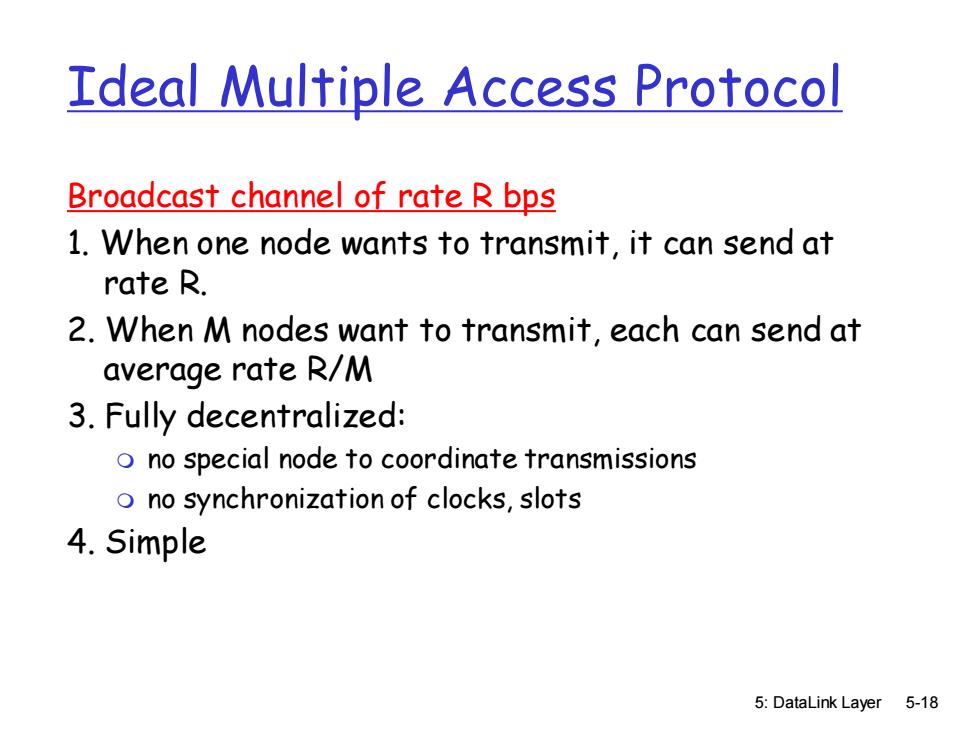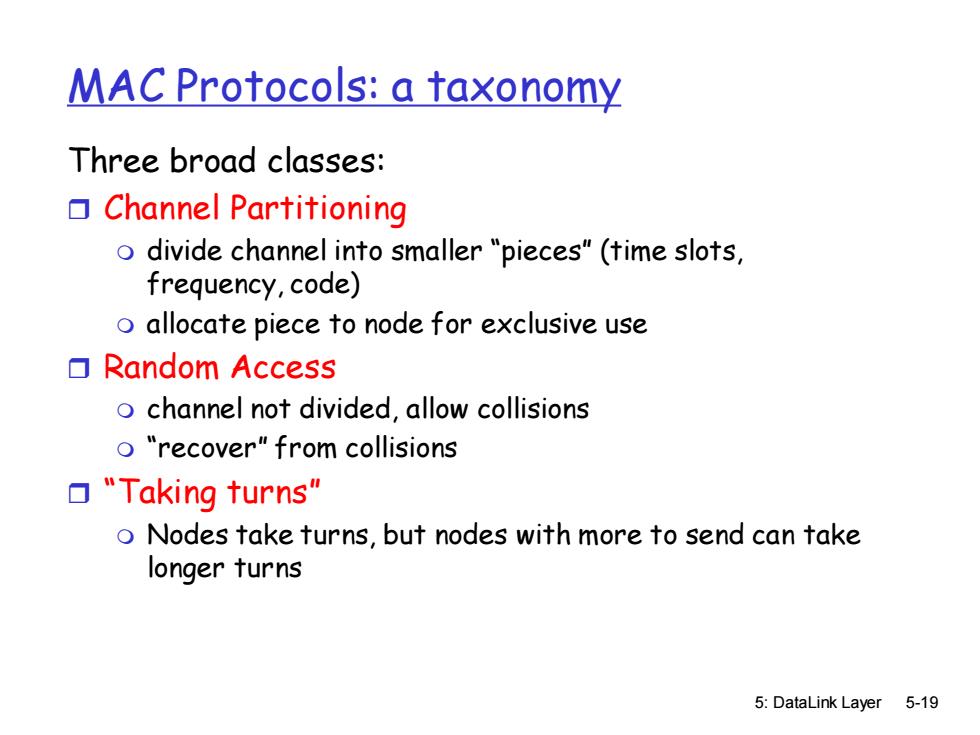
Multiple Access Links and Protocols Two types of "links": ▣point-to-point PPP for dial-up access o point-to-point link between Ethernet switch and host broadcast (shared wire or medium) o Old-fashioned Ethernet o upstream HFC o802.11 wireless LAN Blah,blah,blah ●9 shared wire shared wireless satellite cocktail party (e.g.Ethernet) (e.g.Wavelan) 5:DataLink Layer 5-16
5: DataLink Layer 5-16 Multiple Access Links and Protocols Two types of “links”: point-to-point PPP for dial-up access point-to-point link between Ethernet switch and host broadcast (shared wire or medium) Old-fashioned Ethernet upstream HFC 802.11 wireless LAN

Multiple Access protocols single shared broadcast channel two or more simultaneous transmissions by nodes: interference o collision if node receives two or more signals at the same time multiple access protocol distributed algorithm that determines how nodes share channel,i.e.,determine when node can transmit communication about channel sharing must use channel itself! o no out-of-band channel for coordination 5:DataLink Layer 5-17
5: DataLink Layer 5-17 Multiple Access protocols single shared broadcast channel two or more simultaneous transmissions by nodes: interference collision if node receives two or more signals at the same time multiple access protocol distributed algorithm that determines how nodes share channel, i.e., determine when node can transmit communication about channel sharing must use channel itself! no out-of-band channel for coordination

Ideal Multiple Access Protocol Broadcast channel of rate R bps 1.When one node wants to transmit,it can send at rate R. 2.When M nodes want to transmit,each can send at average rate R/M 3.Fully decentralized: o no special node to coordinate transmissions o no synchronization of clocks,slots 4.Simple 5:DataLink Layer 5-18
5: DataLink Layer 5-18 Ideal Multiple Access Protocol Broadcast channel of rate R bps 1. When one node wants to transmit, it can send at rate R. 2. When M nodes want to transmit, each can send at average rate R/M 3. Fully decentralized: no special node to coordinate transmissions no synchronization of clocks, slots 4. Simple

MAC Protocols:a taxonomy Three broad classes: Channel Partitioning o divide channel into smaller "pieces"(time slots, frequency,code) o allocate piece to node for exclusive use ▣Random Access o channel not divided,allow collisions o "recover"from collisions ▣"Taking turns" o Nodes take turns,but nodes with more to send can take longer turns 5:DataLink Layer 5-19
5: DataLink Layer 5-19 MAC Protocols: a taxonomy Three broad classes: Channel Partitioning divide channel into smaller “pieces” (time slots, frequency, code) allocate piece to node for exclusive use Random Access channel not divided, allow collisions “recover” from collisions “Taking turns” Nodes take turns, but nodes with more to send can take longer turns

Channel Partitioning MAC protocols:TDMA TDMA:time division multiple access access to channel in "rounds" each station gets fixed length slot (length=pkt trans time)in each round unused slots go idle example:6-station LAN,1,3,4 have pkt,slots 2,5,6 idle frame 34 34L 5:DataLink Layer 5-20
5: DataLink Layer 5-20 Channel Partitioning MAC protocols: TDMA TDMA: time division multiple access access to channel in "rounds" each station gets fixed length slot (length = pkt trans time) in each round unused slots go idle example: 6-station LAN, 1,3,4 have pkt, slots 2,5,6 idle